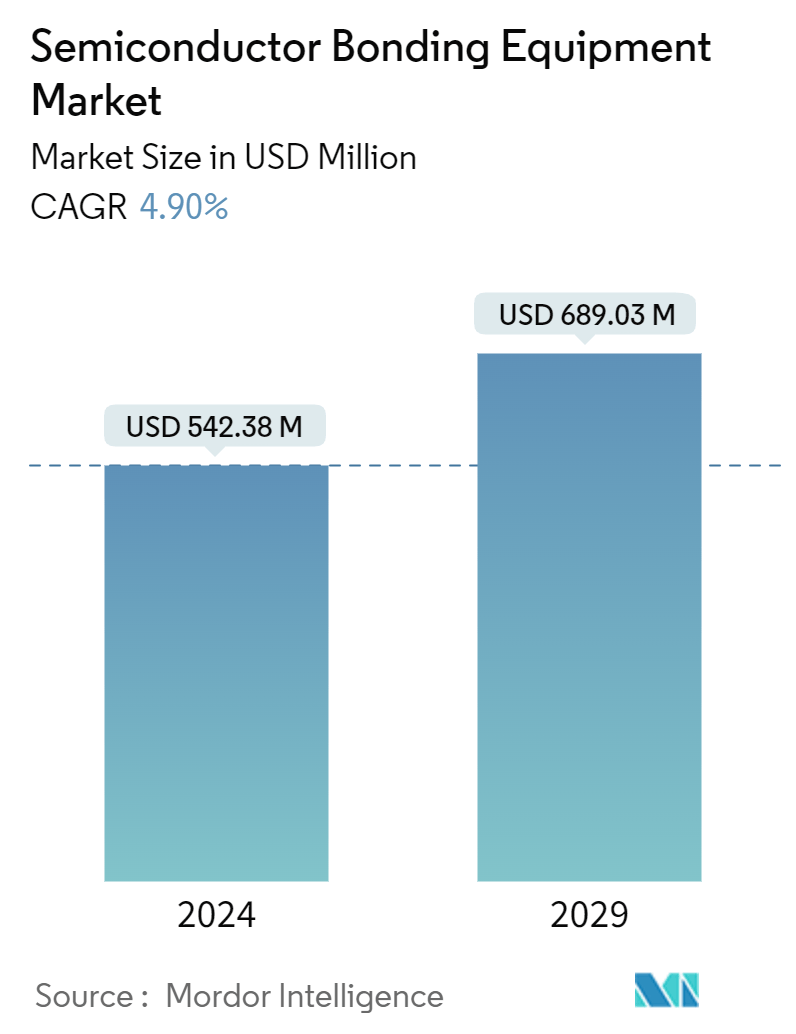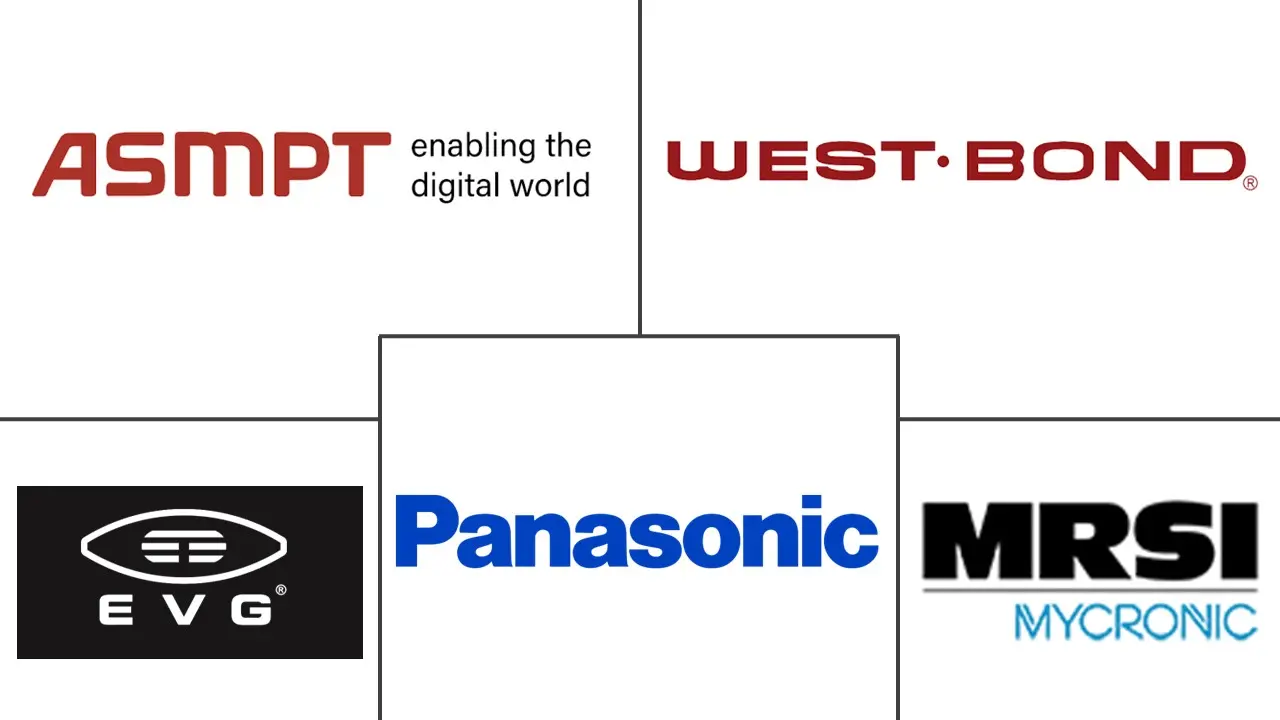Market Size of Semiconductor Bonding Equipment Industry

| Study Period | 2019 - 2029 |
| Market Size (2024) | USD 542.38 Million |
| Market Size (2029) | USD 689.03 Million |
| CAGR (2024 - 2029) | 4.90 % |
| Fastest Growing Market | Asia Pacific |
| Largest Market | Asia Pacific |
Major Players*Disclaimer: Major Players sorted in no particular order |
Semiconductor Bonding Equipment Market Analysis
The Semiconductor Bonding Equipment Market size is estimated at USD 542.38 million in 2024, and is expected to reach USD 689.03 million by 2029, growing at a CAGR of 4.90% during the forecast period (2024-2029).
Semiconductor bonding equipment finds application owing to the rising demand for semiconductor chips with higher efficiency, processing power, and smaller footprint, thereby driving the demand for the market during the forecast period.
- As the impact of digitalization has increased, semiconductor markets have boomed. Notably, this has further resulted in government programs to support the 5G deployment. For instance, the European Commission recognized the importance of the 5G network early and established a public-private partnership to develop and research 5G technology.
- With chip demand set to surge over the coming decade, the global semiconductor industry is expected to become a trillion-dollar industry by 2030. This growth is favored by companies and countries funneling vast sums of money into semiconductor manufacturing, materials, and research to guarantee a constant supply of chips and know-how to support growth across a broad swath of increasingly data-centric industries.
- The semiconductor industry, which makes crucial technological components, has been hitting the headlines due to a rampant demand increase. A recent Wall Street Journal report shows that semiconductors rank as the world's fourth-largest traded product (imports and exports, counted), after crude oil, refined oil, and cars. This is because semiconductors are critical for high-computing applications in various industries, including electronics and manufacturing industries, agriculture, healthcare, infrastructure, entertainment, transportation, telecommunications, military systems, energy management, and space, to name just a few.
- Several methods might be used when a product needs the bonding of two dies or wafers. Not only does the type of bonding method itself have to be selected, but it must also be decided whether the items being bonded will be in wafer or die form. The selected bonding process is the primary driver for the cost of ownership of bonding. For a given process, the three most important factors are the cost of the upstream process needed for bonding, the cycle time of the bonding process, and the yield of the bonding process.
- With the global outbreak of the pandemic and restrictive measures taken to control the spread of COVID-19, the global supply chain of the semiconductor bonding equipment industry was significantly disrupted, impacting the production capabilities of various companies. Although the number of COVID-19-infected patients decreased considerably, salient issues with materials supply and demand for these components still need to be addressed, challenging the market's growth.
Semiconductor Bonding Equipment Industry Segmentation
Wafer bonding is the process of adhering a thin substrate wafer to a support carrier disc using wafer substrate bonding units. Several bonding techniques are used to achieve this, requiring various equipment or machinery. Equipment types include permanent bonding, temporary bonding, and hybrid bonding. The scope of the bonding equipment market is limited to applications such as advanced packaging, power IC and power discrete, photonic devices, MEMS sensors and actuators, engineered substrates, RF devices, and CMOS image sensors (CIS).
The semiconductor bonding equipment market is segmented by type (permanent bonding equipment, temporary bonding equipment, hybrid bonding equipment), application (advanced packaging, power IC and power discrete, photonic devices, MEMS sensors and actuators, engineered substrates, RF devices, CMOS image sensors (CIS)), and geography (North America, Asia, Europe, Latin America, and Middle East & Africa). The market sizes and forecasts are provided in terms of value in USD for all the above segments.
| By Type | |
| Permanent Bonding Equipment | |
| Temporary Bonding Equipment | |
| Hybrid Bonding Equipment |
| By Application | |
| Advanced Packaging | |
| Power IC and Power Discrete | |
| Photonic Devices | |
| MEMS Sensors and Actuators | |
| Engineered Substrates | |
| RF Devices | |
| CMOS Image Sensors (CIS) |
| By Geography | |
| North America | |
| Europe | |
| Asia | |
| Australia and New Zealand | |
| Latin America | |
| Middle East and Africa |
Semiconductor Bonding Equipment Market Size Summary
The semiconductor bonding equipment market is poised for significant growth, driven by the increasing demand for semiconductor chips that offer higher efficiency and processing power in a compact form. This demand is further fueled by the rapid digitalization across various sectors and the push for 5G deployment, as evidenced by initiatives like the European Commission's public-private partnership. The semiconductor industry, a crucial component of the global supply chain, is experiencing a surge in demand due to its essential role in high-computing applications across diverse industries such as electronics, healthcare, and telecommunications. The market's expansion is supported by substantial investments in semiconductor manufacturing and research, aiming to ensure a steady supply of chips to meet the needs of data-centric industries.
The market for semiconductor bonding equipment is also influenced by the growing importance of power semiconductor devices, which are vital for efficient power management and energy conservation. The rise in connected devices and the shift towards electrification in the automotive industry are key factors driving the demand for power ICs and bonding technology. The industry's growth is further supported by advancements in IoT applications and the increasing prevalence of smart devices, which necessitate advanced bonding equipment. Asia-Pacific, particularly countries like China, Taiwan, and South Korea, plays a significant role in the market due to its substantial share of semiconductor foundries and ongoing investments in manufacturing capacities. The market is characterized by fragmentation, with major players like EV Group and MRSI Systems actively expanding their operations and enhancing their product offerings to maintain a competitive edge.
Semiconductor Bonding Equipment Market Size - Table of Contents
-
1. MARKET INSIGHTS
-
1.1 Market Overview
-
1.2 Market Attractiveness - Porter's Five Forces Analysis
-
1.2.1 Bargaining Power of Suppliers
-
1.2.2 Bargaining Power of Buyers
-
1.2.3 Threat of New Entrants
-
1.2.4 Threat of Substitutes
-
1.2.5 Intensity of Competitive Rivalry
-
-
1.3 Industry Value Chain/Supply Chain Analysis
-
1.4 Impact of COVID-19 on the Market
-
-
2. MARKET SEGMENTATION
-
2.1 By Type
-
2.1.1 Permanent Bonding Equipment
-
2.1.2 Temporary Bonding Equipment
-
2.1.3 Hybrid Bonding Equipment
-
-
2.2 By Application
-
2.2.1 Advanced Packaging
-
2.2.2 Power IC and Power Discrete
-
2.2.3 Photonic Devices
-
2.2.4 MEMS Sensors and Actuators
-
2.2.5 Engineered Substrates
-
2.2.6 RF Devices
-
2.2.7 CMOS Image Sensors (CIS)
-
-
2.3 By Geography
-
2.3.1 North America
-
2.3.2 Europe
-
2.3.3 Asia
-
2.3.4 Australia and New Zealand
-
2.3.5 Latin America
-
2.3.6 Middle East and Africa
-
-
Semiconductor Bonding Equipment Market Size FAQs
How big is the Semiconductor Bonding Equipment Market?
The Semiconductor Bonding Equipment Market size is expected to reach USD 542.38 million in 2024 and grow at a CAGR of 4.90% to reach USD 689.03 million by 2029.
What is the current Semiconductor Bonding Equipment Market size?
In 2024, the Semiconductor Bonding Equipment Market size is expected to reach USD 542.38 million.


